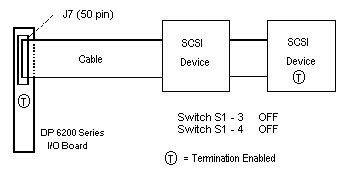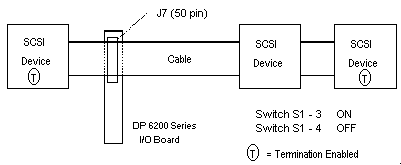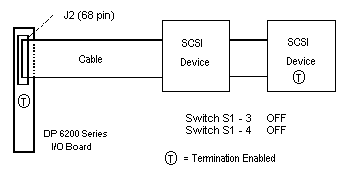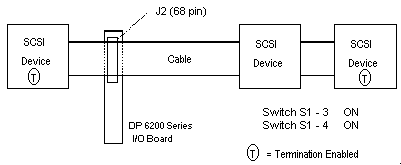DP6200 Series For PowerSMP
Chapter 3 - Installation
DP 6200 Series Board Installation
Installation in a Cubix PowerSMP System
SCSI Device Installation
The Symbios SCSI adapter on the DP Series support:Note: The SCSI adapter defaults to device 7.
The board is equipped with an integrated fast/wide SCSI adapter. The adapter is enabled or disabled via the Chipset option of the BIOS Setup utility and via hardware with jumpers JP2. The SCSI adapter is a bus master device which gain control of the PCI bus to transfer data between the CPU memory and the SCSI devices. The I/0 base address and interrupts are set by the PCI plug and play BIOS at boot time.
A SCSI configuration utility is available on boot-up of the board. Shortly after the SCSI BIOS information displays, the configuration program can be accessed by pressing Control C. The configuration utility will allow you to scan the SCSI bus, change configuration options, and view a list of SCSI devices connected to the board. If the SCSI BIOS is inadvertently turned off in the SCSI configuration utility, turn it back on by holding <CTRL> A when the board is reset.
Termination - SCSI Adapter (external SCSI devices)
SCSI termination is controlled by dip switches 3-6 of switch 1 on the I/O board. The factory default is all switches OFF, which terminates connector J4 (on end bracket) as one end of the SCSI chain.See figures 3-1 through 3-4 for termination switch settings.

Figure 3-1, 8 bit External OR Internal SCSI Devices

Figure 3-2, 8 bit External AND Internal SCSI Devices

Figure 3-3, 16 bit External OR Internal SCSI Devices

Figure 3-4, 16 bit External AND Internal SCSI Devices
Termination should also be configured as enabled if the SCSI interface is not used. The last device on the SCSI cable must also supply a termination load to the cable. SCSI devices not at the end of the cable must have their termination loads disconnected.
Enabling and disabling a SCSI device's termination may involve a switch or shunt setting or the installation or removal of resistive SIP or DIP packages on their circuit board. Consult the installation manual for the SCSI device to determine its termination options.
Optional Peripheral Adapter Installation
An optional breakout adapter board that contains two COM ports and a parallel port may be added on the DP Series board. This requires a Cubix printed circuit board which provides an interface between the header on the I/O board and the two DB9 and the DB25 connector.WARNING!
MAKE SURE THE SYSTEM IS POWERED OFF AND
UNPLUGGED BEFORE BEGINNING THIS PROCEDURE.
Ethernet 10/100 Base-T Installation
The board is equipped with an integral DEC 21140 PCI fast Ethernet controller with a RJ-45 10/100 BASE-T connector (J9) on the mounting bracket at the rear of the board. The adapter is enabled or disabled via the "Chipset" option of the BIOS Setup utility and via hardware with jumper JP1. The I/O addresses and interrupts are set by the PCI plug and play BIOS at boot time. Software drivers are provided for this controller to support PC local area networks.Near the RJ-45 connector and visible in the mounting bracket are two sets of light emitting diodes (LED). On the lower set, the green LED will light when the interface has a valid connection to an Ethernet hub. The amber LED will light when the interface is set to 100 Mbit/s. On the upper set, the green LED indicates network activity, and the amber LED indicates a data collision on the network. These LEDs can be useful indicators of network activity.
Software InstallationOverview
To fully utilize all of the features integrated into the SP Series processors, the following software drivers and utilities are available on diskette, or can be obtained from the Cubix Customer Service Web site at: http://www.cubix.com/support
This document, and all Web contents, Copyright © 2000 by Cubix Corp., Carson City, NV, USA.